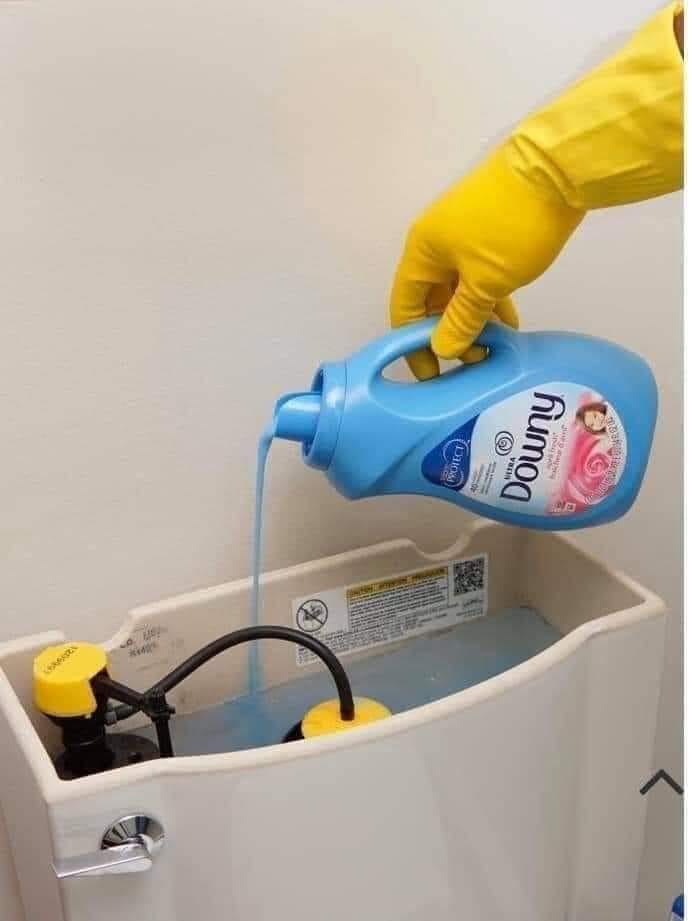The idea of using laundry detergent or fabric softener in the toilet tank comes from the desire for a constantly pleasant-smelling bathroom without frequent cleaning or maintenance. The concept is that each flush releases a fresh scent, keeping the space smelling clean and inviting.
Using laundry detergent or fabric softener in the toilet tank to create a pleasant aroma might seem like a convenient hack, but it’s essential to be cautious about the potential risks involved. Here’s a breakdown of what to consider before trying this:
In-depth Examination of Risks and Issues
- Mechanical Issues:
- Clogging and Residue: The detergent may leave a sticky residue that can clog the fill valve, flapper, or other mechanisms. Over time, this can lead to the toilet not flushing correctly or even continuously running.
- Wear and Tear: Components like gaskets and seals are particularly susceptible to the effects of harsh chemicals. As these parts wear out, leaks can develop, leading to water waste and potential damage.
- Water Efficiency Concerns:
- Increased Water Usage: A malfunctioning toilet due to detergent build-up can lead to inefficiencies in water usage. Toilets might not flush properly, necessitating multiple flushes and wasting water.
- Environmental Consequences:
- Chemical Runoff: The continual flushing of detergent-laden water can introduce a steady stream of surfactants and fragrances into the wastewater system, potentially affecting aquatic life and water quality.
- Biodiversity Impact: The disruption caused by these chemicals can affect the microbial life in water treatment facilities, which plays a crucial role in maintaining a balanced ecosystem.
Alternative Solutions for a Pleasant-Smelling Bathroom
- Innovative Air Freshening Techniques:
- Natural Air Purifiers: Utilize indoor plants known for their air-purifying qualities, such as spider plants, peace lilies, or snake plants, which help in neutralizing odors and improving air quality.
- DIY Potpourri Jars: Create a potpourri mix using dried flowers, herbs, and essential oils. Place these in decorative jars or bowls around the bathroom for a subtle, natural fragrance.
- Enhanced Cleaning Practices:
- Scheduled Deep Cleaning: Regularly deep clean your bathroom, focusing on areas that can harbor odors like drains, shower curtains, and grout. Use natural cleaning agents like vinegar, lemon juice, and baking soda for effective results.
- Use of Steam Cleaners: Steam cleaning is a chemical-free method that effectively sanitizes surfaces, killing bacteria and eliminating odors without harmful chemicals.
- Advanced Ventilation Solutions:
- Automatic Fans: Install fans with humidity and motion sensors that automatically run when needed, ensuring optimal air circulation and reducing moisture and odors.
- Window Treatments: Install windows that open easily or enhance existing windows with treatments that facilitate better airflow.
- Utilizing Technology:
- Smart Air Fresheners: Consider smart air fresheners that release scent based on room usage and time, ensuring a consistent pleasant smell without overpowering fragrances.
- Homemade Deodorizers:
- Vinegar and Citrus Spray: Combine vinegar with citrus peels and let it sit for a few days. This creates a potent natural deodorizer that can be sprayed as needed.
- Baking Soda Shakers: Fill small containers with baking soda and a few drops of essential oil. Place these in corners to continuously absorb odors.
Final Thoughts
Maintaining a fresh-smelling bathroom is not just about masking odors but creating a space that is clean, well-ventilated, and free from harmful chemicals. While the idea of using laundry detergent or softener in the toilet tank might seem appealing for its simplicity, the potential risks to your plumbing and environmental health far outweigh the benefits. By exploring alternative solutions that are both effective and eco-friendly, you can achieve a refreshing and inviting bathroom environment without compromising on safety or sustainability.
